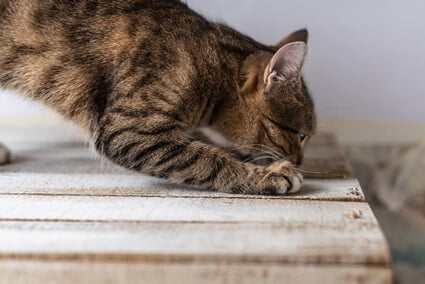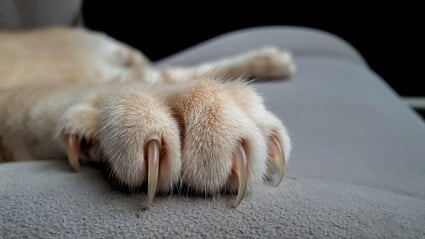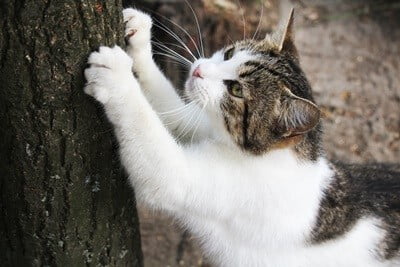You may discover a small, translucent object that looks similar to your cat’s claw. However, upon closer inspection, the cat has all its nails, and what you’ve witnessed is natural claw-shedding.
The outer layer of keratin, known as a sheath, naturally detaches from the rest of the claw once it’s finished its 2-3 month lifecycle of protecting your cat’s claws. Underneath are the new layers that have grown in during this time, allowing the cat to have stronger, sharper, and healthier claws.
Cats remove their sheaths by scratching posts, carpets, and other surfaces. It causes no pain or discomfort for the cat and is a normal part of having nails. However, there are rare instances when a sheath doesn’t remove itself.
Is It Normal For Cats To Shed Their Claws?
It’s normal for cats to shed their claws. However, keep in mind that cats don’t shed their claws in the way the term implies. Unlike a reptile shedding its skin, a cat shouldn’t lose its entire nail at once.
If this happened, it would lead to severe discomfort and bleeding. It’s a rare occurrence and usually results from an injury, and such an event doesn’t constitute shedding claws in the healthy, natural sense.
Instead, if you hear of a cat naturally shedding its claws, it refers to the thin outer layer of keratin on its nail. Nails are composed of several layers of keratin, so a cat can afford to lose a few layers as the nail regenerates to be stronger.
According to the Journal of Anatomy, the sheath only sheds when the nail has grown beyond its blood supply. The outside shell becomes dry, sheds, and makes room for a newer, sharper, and more robust claw layer.
Cats often shed the sheath of their claws while scratching a surface, and it’s why you will see these layers discarded around your cat’s scratching post or stuck to your carpet fibers.
Claws can shed in an instant when pulled on by a rough surface, so your cat will continue with what it’s doing.
How Do Cats Shed Their Claws?
A cat’s claws are deceptively thick, composed of multiple layers of keratin.
These layers work to give the cat talon its strength and resiliency. As the claws grow out, their outer layers start to break down and shed away.
This outside layer is known as the sheath of the claw. As the name implies, it only comes off once it’s cleanly detached itself from the rest of the claw.
In natural conditions, it’ll never be ripped free or cause any discomfort. It merely detaches once it’s finished its lifecycle of protecting the claw and is then discarded.
Losing an outer layer of the nail is healthy as it ensures your cat will have fresher, more robust layers underneath. So, don’t worry if you notice the sheaths lying around your cat’s scratching post after a rigorous scratching session.
Your cat is not hurting itself or its paws in the process. It’s actively scratching its claws to remove the sheaths and welcome the newer, sharper claws into its routine.
Moreover, the sheath-shedding ensures that your cat’s talons don’t continue growing beyond their necessary length. Otherwise, the overgrowth would result in them curling over and piercing your cat’s toe pads.
Do House Cats Shed Their Claws?
Cats shed their claws as a result of use and growth. In other words, the outer layers get worn down by scratching and need to regenerate.
However, they also grow beyond the blood supply naturally and begin to die off. When paired together, this system is a natural way for cats to ensure their nails don’t get too long.
Feral cats and house cats alike shed their claws. All cats, even those which rarely use their claws, will shed them eventually. Your house cat’s nails still grow, after all, and this requires the sheaths to flake away.

Do All Cats Shed Their Claws?
All species of cats shed their claws. Because all breeds have the same keratin layers that make up their talons, they need to naturally shed these to maintain nails that are strong, sharp, and resilient to damage.
There are no species that are exempt from this process. It’s a natural, evolutionary feature that ensures cats don’t get stuck with brittle or worn-down nails.
It’s also an adaptation that keeps cats from growing their nails too long. Scratching at posts, trees, or other surfaces sand them down, and sheath-shedding does the rest.
Do Cats Shed Their Back Claws?
Just like the front claws, cats will shed their back claws too.
This isn’t a matter of “how much does the claw get used,” but whether or not the claws exist. Cats will sharpen their front and back claws through scratching, walking, and climbing and the sheaths on both will come off.
The back claws also grow steadily, which means the sheaths will eventually grow beyond the blood supply. The sheaths will become weak and detach when this happens, getting pulled off as your cat scratches or walks.
How Often Does a Cat Shed Its Claws?
Cats can shed the upper layer of their claws every 2-3 months. This is how long it takes for the lower layers of the claw to grow out and become the upper layers in a cycle.
Not all talons will shed all at once, so you may find some flaking off while others remain. This could leave your feline to lose a sheath on a seemingly random basis.
You can check to see how the progress is going visually. Compared to the other claws, newly shed sheaths should reveal a newer, sharper layer of your cat’s claws.
Why Is My Cat Not Shedding Its Claws?
Most cats shed their claws while scratching a surface. If your cat scratches less often, it may have difficulty removing its sheaths. If left, sheaths can lead to overgrowth and cause problems, such as infection and pain.
Older cats develop thicker nails and may have less energy to scratch those sheaths off. Unwell cats may also struggle to use their nails like they normally would.
Moreover, polydactyl cats have an extra toenail that lacks the ligaments to extend, scratch, and shed normally. This toenail, at times, must be trimmed to avoid overgrowth.
If your cat’s talons won’t shed, the claws will continue to grow and eventually curl. This will cause them to grow into paw pads and cause your cat avoidable pain.
However, this can be avoided with the following:

Several Scratching Posts
Cats are used to scratching their claws on textured surfaces, especially trees, to ensure healthy shedding. So, provide various options to use as scratching posts or surfaces.
According to the Journal of Feline Medicine and Surgery, some cats prefer to scratch on horizontal surfaces, such as carpets. Meanwhile, others prefer a vertical scratching post. If your elderly cat isn’t showing interest in one type of post, you may encourage it to scratch more with another type.
Play Toys
Cats also lose their sheaths by tussling with prey. So, it’s important to provide a range of toys, so your cat can sink its claws into the playthings and pull its sheaths off.
You can find a wide array of store-bought items made from:
- Wood
- Rope
- Corrugated cardboard
These are ideal for tossing around and for scratching.
Clip the Nails Regularly
If your cat’s nails are overgrowing because the sheaths are not falling off, you can intervene. Clipping the tips of the nails regularly will prevent curling and eventually pain.
You can also use this opportunity to pull gently at your cat’s nails to see if you can gradually remove the sheaths yourself. Not all cats will be comfortable enough to allow this, making toys and scratching posts ideal.
Cats are supposed to shed their claws, which is a natural, healthy activity. By providing the right items and toys for the cat to carry out this process on its own, you’re ensuring that it’ll have stronger, healthier talons.

